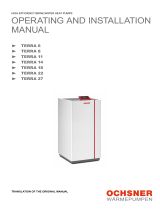
2 | WPF basic www.stiebel-eltron.com
CONTENTS
SPECIAL INFORMATION
OPERATION
1. General information �����������������������������������������3
1.1 Safety instructions ����������������������������������������������� 3
1.2 Other symbols in this documentation ����������������������� 4
1.3 Units of measurement ������������������������������������������ 4
1.4 Standardised output data �������������������������������������� 4
2. Safety ���������������������������������������������������������� 4
2.1 Intended use ������������������������������������������������������ 4
2.2 Safety information ����������������������������������������������� 4
2.3 Test symbols ������������������������������������������������������ 4
3. Appliance description ���������������������������������������4
3.1 Energy saving tip ����������������������������������������������� 5
4. Operation �����������������������������������������������������5
4.1 Operation ���������������������������������������������������������� 6
4.2 Essential facts in brief ������������������������������������������ 6
4.3 Adjustments at control level 1 �������������������������������� 7
4.4 Overview of control level 2������������������������������������� 7
4.5 Adjustments at control level 2 �������������������������������� 8
4.6 Remote control FE7 �������������������������������������������� 17
4.7 Remote control FEK �������������������������������������������� 17
5. Maintenance and care ������������������������������������� 17
6. Troubleshooting �������������������������������������������� 17
6.1 Other problems ������������������������������������������������� 17
INSTALLATION
7. Safety �������������������������������������������������������� 18
7.1 General safety information ����������������������������������� 18
7.2 Instructions, standards and regulations ������������������� 18
8. Appliance description ������������������������������������� 18
8.1 Mode of operation ���������������������������������������������� 18
8.2 Standard delivery ����������������������������������������������� 18
9. Preparations ������������������������������������������������ 18
9.1 General information �������������������������������������������� 18
9.2 Electrical installation������������������������������������������� 19
9.3 Buffer cylinder �������������������������������������������������� 19
10. Mounting ���������������������������������������������������� 19
10.1 Handling ���������������������������������������������������������� 19
10.2 Positioning ������������������������������������������������������� 19
10.3 Removing the casing panels ���������������������������������� 20
10.4 Installing the heat source system ��������������������������� 20
10.5 Heating water connection ������������������������������������� 22
10.6 Oxygen diffusion ������������������������������������������������ 22
10.7 Filling the heating system ������������������������������������ 22
10.8 Venting the heating system ����������������������������������� 22
10.9 Minimum flow rate of heat sink for WPF 5-16 basic ����� 23
10.10 Flow rate of heat sink for WPF 5-10 S basic ��������������� 24
10.11 DHW heating ����������������������������������������������������� 24
10.12 Electrical connection ������������������������������������������� 24
10.13 Fitting the casing parts ���������������������������������������� 28
10.14 installation ������������������������������������������������������� 29
10.15 High limit safety cut-out for underfloor heating
systems STB-FB ������������������������������������������������� 29
10.16 Remote control FE7 �������������������������������������������� 30
10.17 Remote control FEK �������������������������������������������� 30
11. Commissioning ��������������������������������������������� 30
11.1 Checks before commissioning�������������������������������� 30
11.2 Heating curve adjustment during commissioning ������� 31
11.3 Operation and control ����������������������������������������� 31
11.4 Taking the appliance out of use ������������������������������ 31
11.5 Heat pump manager commissioning summary ���������� 32
11.6 Heat pump manager commissioning ����������������������� 34
11.7 WPMiw commissioning report ������������������������������� 41
12. Settings ����������������������������������������������������� 42
12.1 Standard settings ����������������������������������������������� 42
12.2 Heating and DHW programs ���������������������������������� 42
12.3 Appliance handover �������������������������������������������� 42
13. Troubleshooting �������������������������������������������� 43
13.1 Fault display ����������������������������������������������������� 43
13.2 Resetting the high limit safety cut-out ��������������������� 44
13.3 Fault list parameter �������������������������������������������� 45
14. Maintenance ������������������������������������������������ 45
15. Specification ������������������������������������������������ 46
15.1 Connections ������������������������������������������������������46
15.2 Installation dimensions ���������������������������������������� 47
15.3 Wiring diagram WPF 5 basic ���������������������������������48
15.4 Wiring diagram WPF 7 basic | WPF 10 basic | WPF 13
basic | WPF 16 basic ��������������������������������������������50
15.5 Wiring diagram WPF 5-10 S basic ��������������������������� 52
15.6 Output diagrams WPF 5 basic �������������������������������� 54
15.7 Output diagrams WPF 7 basic �������������������������������� 56
15.8 Output diagrams WPF 10 basic ������������������������������58
15.9 Output diagrams WPF 13 basic ������������������������������ 60
15.10 Output diagrams WPF 16 basic ������������������������������ 62
15.11 Output diagrams WPF 5 S basic ������������������������������ 64
15.12 Output diagrams WPF 7 S basic ������������������������������ 65
15.13 Output diagrams WPF 10 S basic ���������������������������� 66
15.14 Data table WPF 5-16 basic ������������������������������������ 67
15.15 Datentabelle WPF 5-10 S basic ������������������������������� 69
15.16 Data table WPMiw ���������������������������������������������� 70
GUARANTEE
ENVIRONMENT AND RECYCLING




















